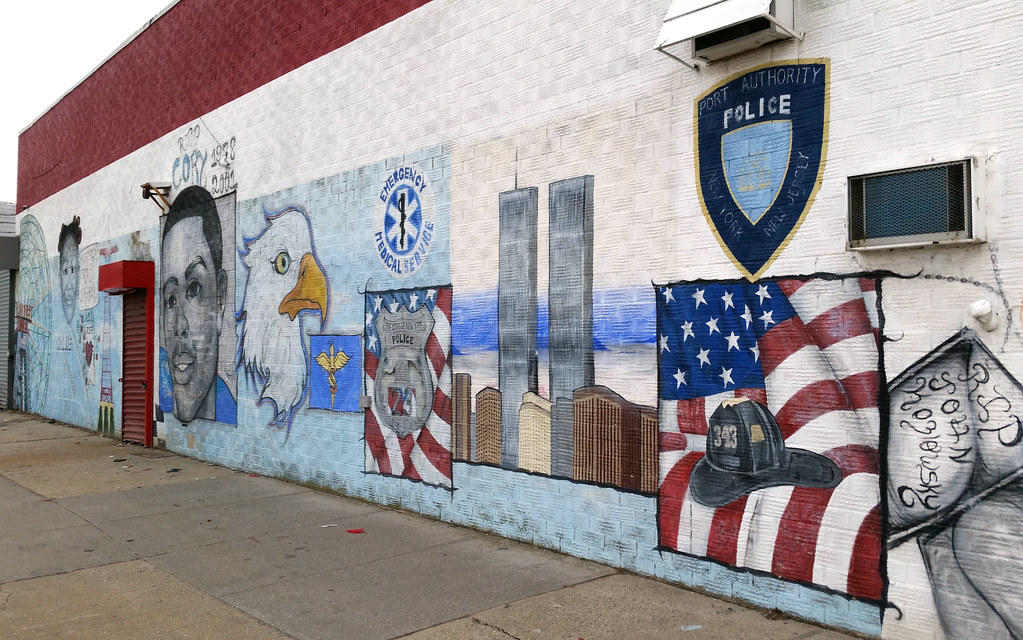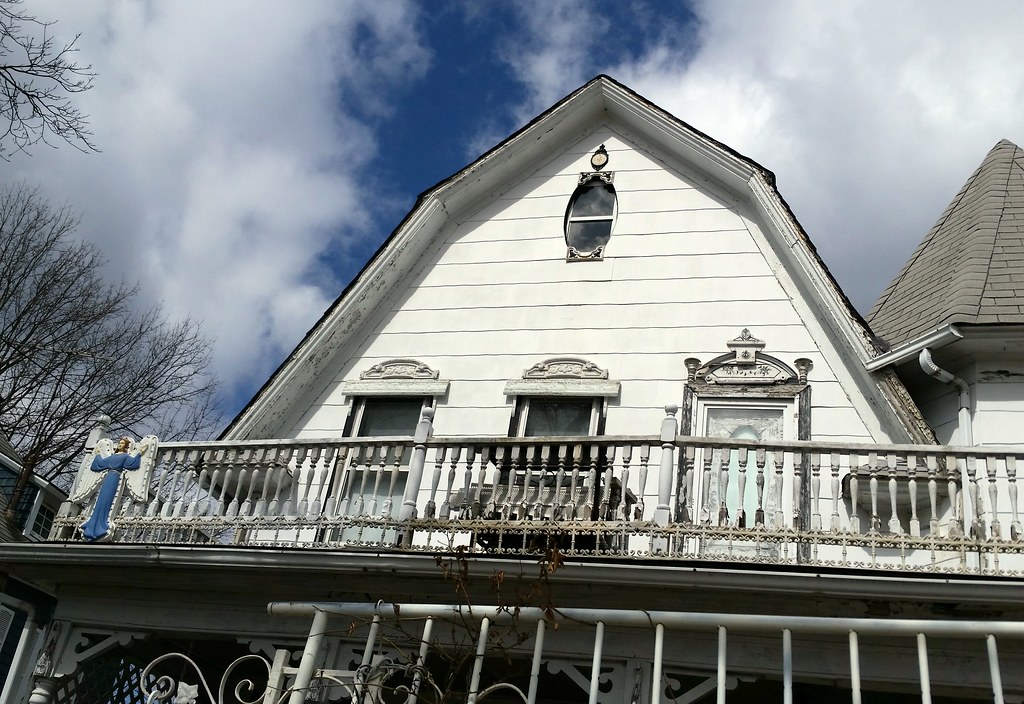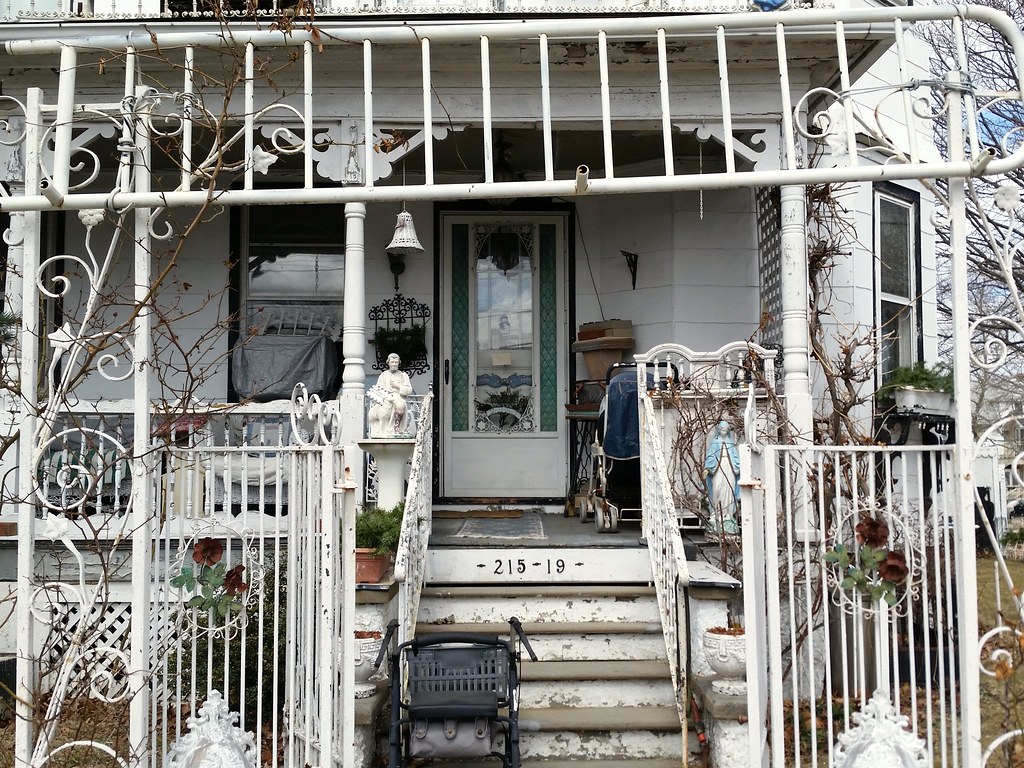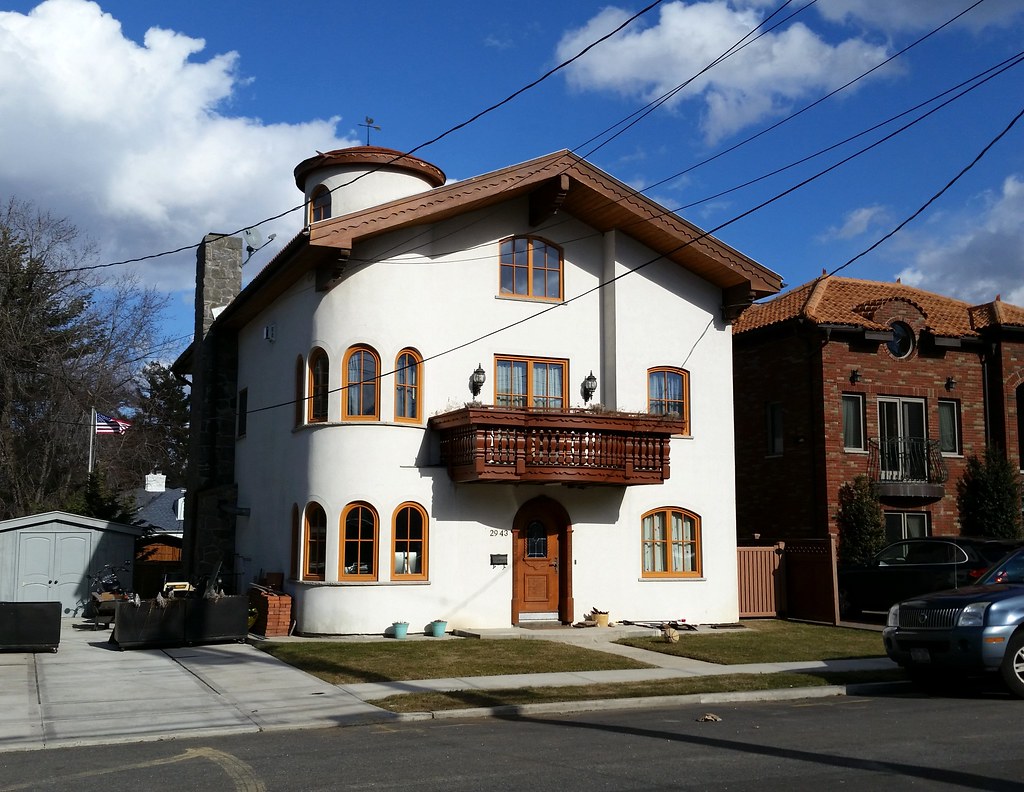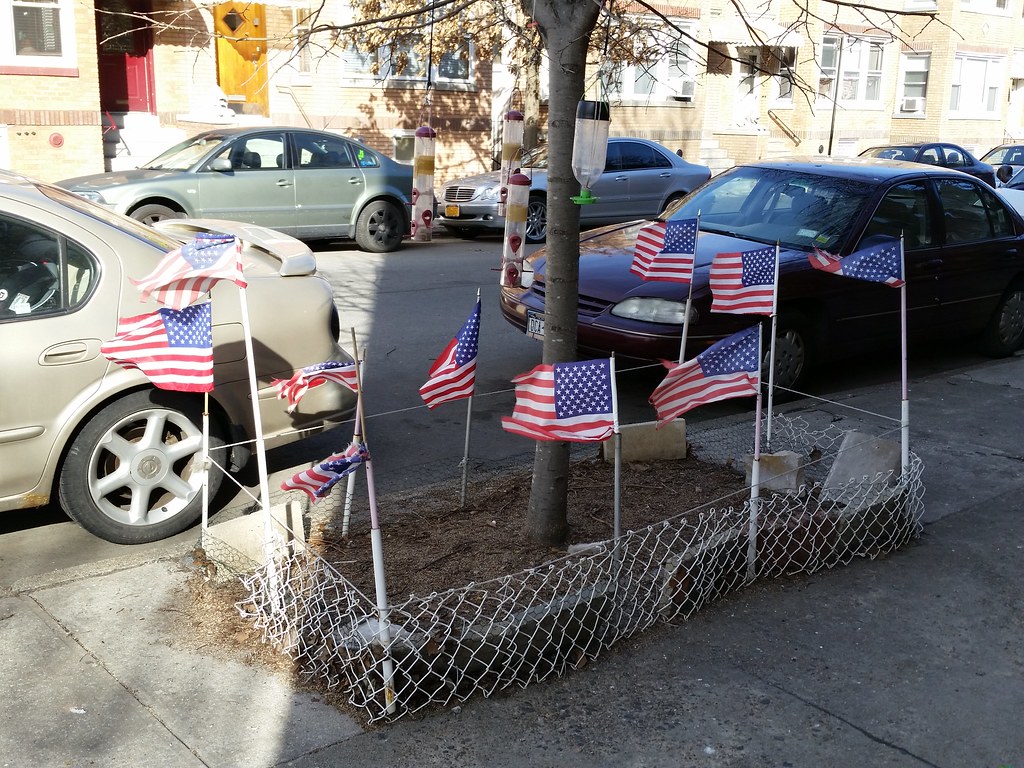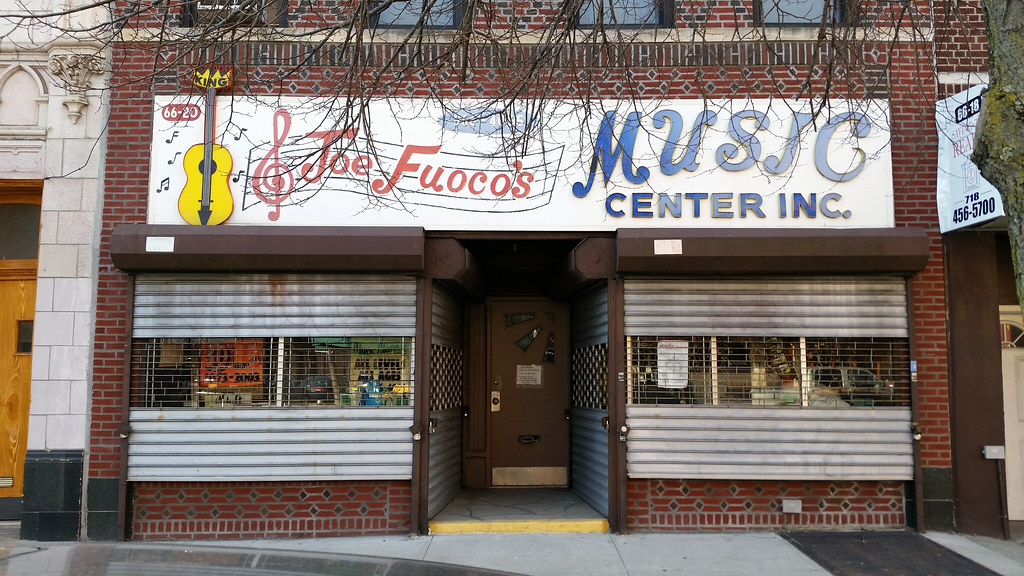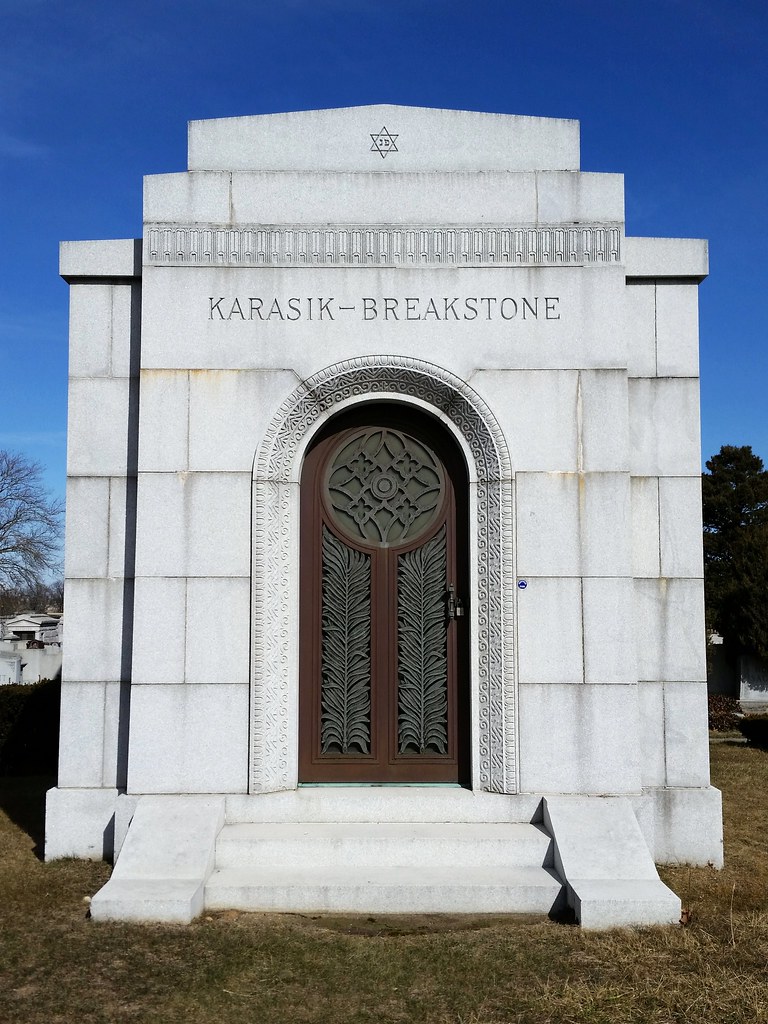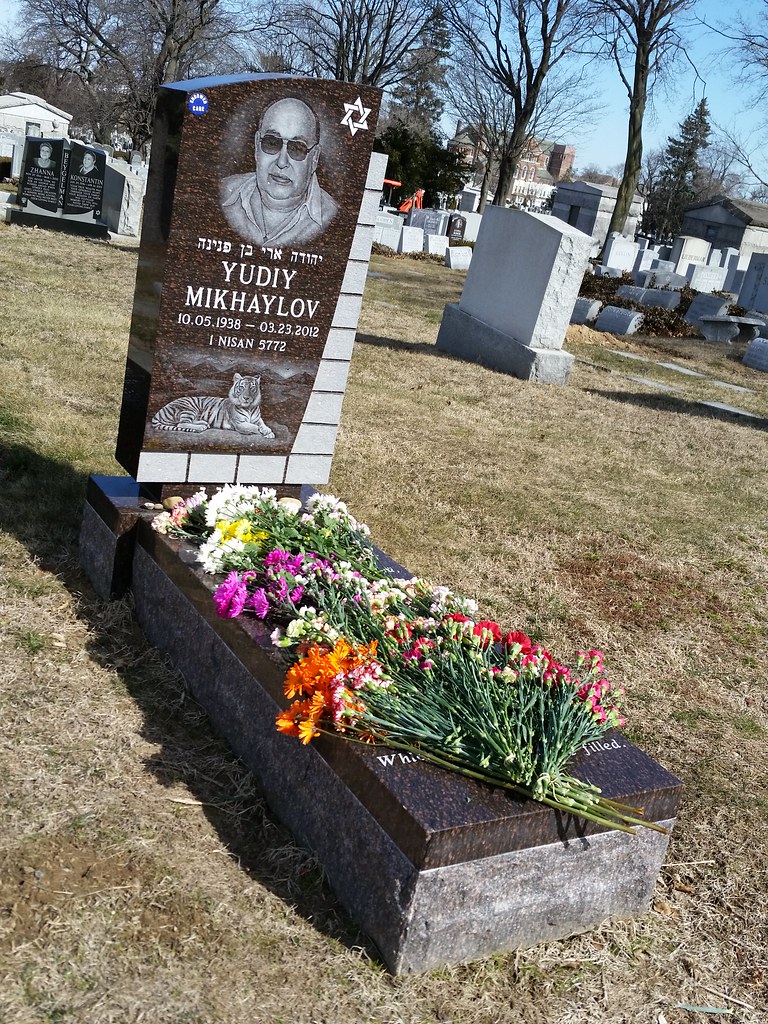
This public transfer high school is housed in what used to be the school of Our Lady of Solace.
UPDATE: Great NY Times article from Sept. 9, 2016: "Minority Youths Mistrust Police. A Brooklyn High School Has a Plan."

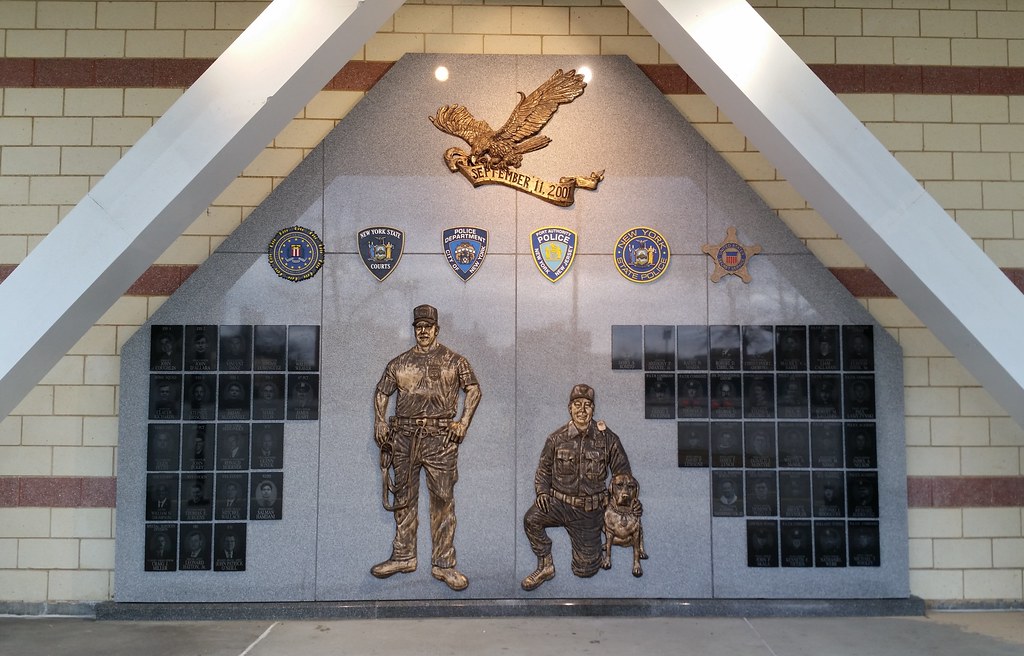
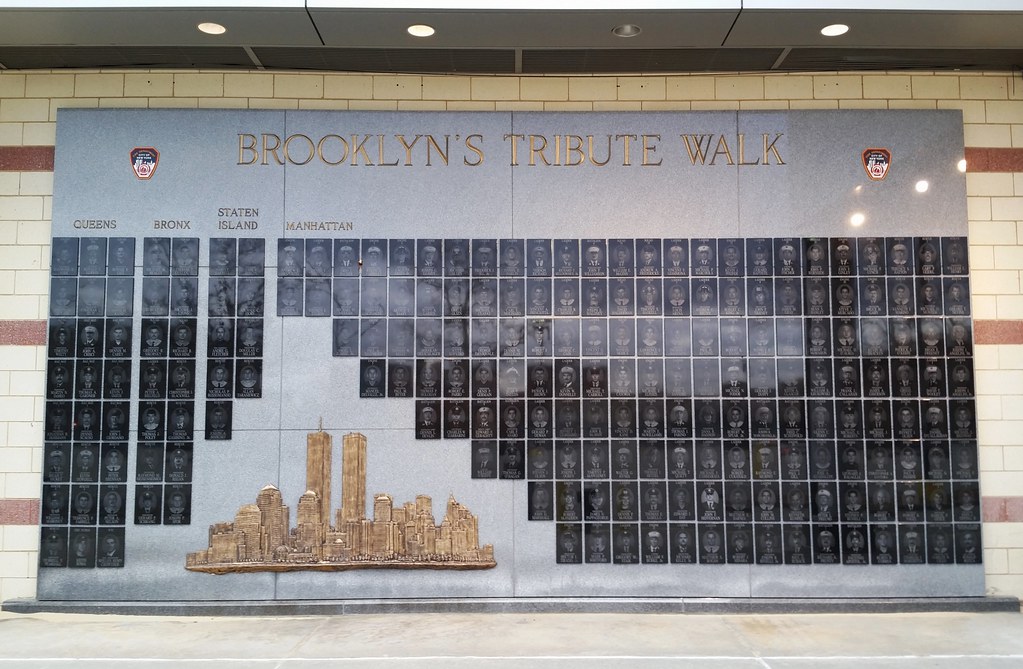
Located at the Brooklyn Cyclones' ballpark, the Brooklyn Wall of Remembrance pays tribute to all the first responders killed on 9/11.
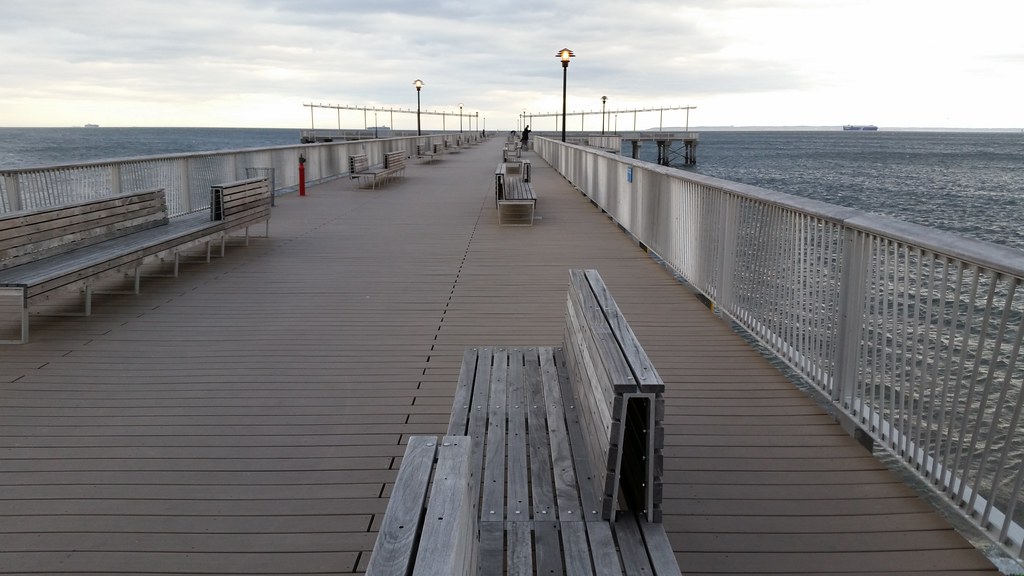
Redesigned and reopened since being damaged by Hurricane Sandy. Here's how it used to look.
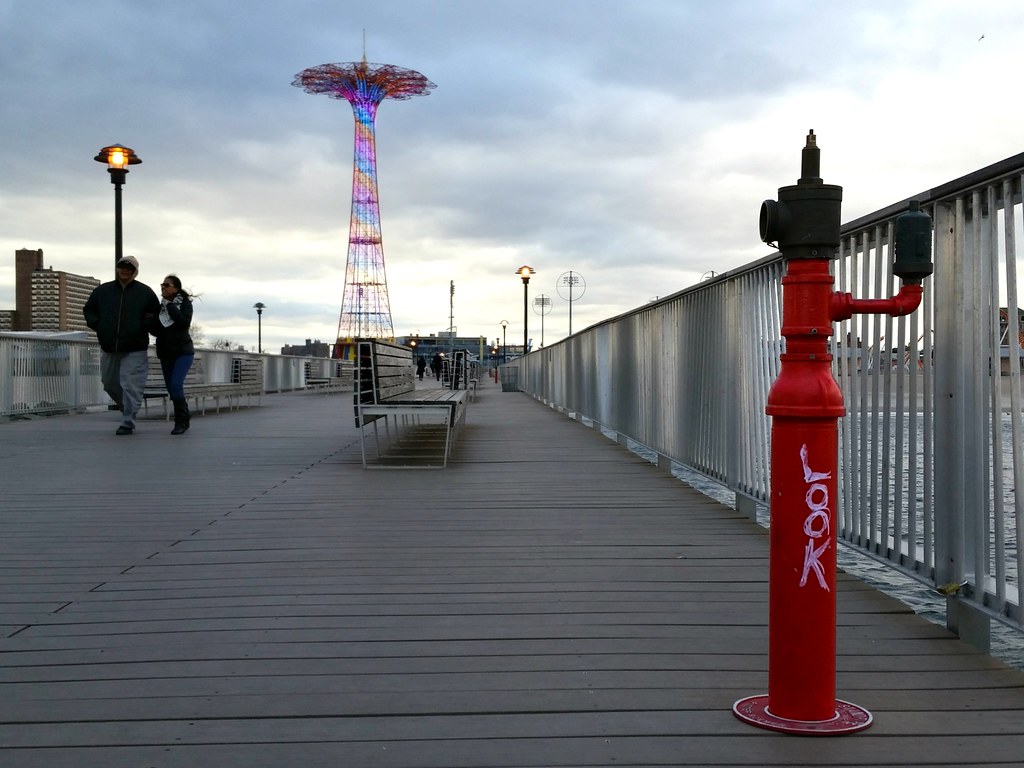
at this standpipe connection, used for fighting fires on Steeplechase Pier. (That's the Parachute Jump lit up in the background.)

This monument outside the Brooklyn Cyclones' stadium commemorates a storied moment in baseball history — when Pee Wee Reese stood in solidarity with his teammate Jackie Robinson against a barrage of racist taunts being hurled at Robinson by opposing fans — although the version of events presented on the monument probably isn't entirely accurate.


This is Our Lady of La Salette, a traditionalist, independent Roman Catholic church that celebrates the Mass in Latin. (Zoom out to see the whole building in Street View; zoom in to see a couple of items stranded atop the left gatepost.) A sign inside the gate reads:
ATTENTION:
Ladies, young ladies, and girls It is unequivocally prohibited, for all women to enter the church for any Liturgical act in pants, immodest, low neckline dresses or tops. Moreover it is mandatory that all women shall cover their heads with a veil.
NOTE: Women who visit the church for the first time shall be given a skirt.
Attention: Men, young men and boys, it is prohibited during springtime and summertime to enter the church in shorts, undershirts and tank tops. Tradition means to respect and honor God.

This is presumably the car of Grace Meng, who represents this part of Queens — the 6th District — in Congress.
Ms. Meng is New York State's first Asian-American member of Congress. Her father, former Assemblyman Jimmy Meng, became the first Asian-American elected to the State Legislature, in 2004. (He was later convicted on bribery charges.)
Ms. Meng won her seat in the House of Representatives in 2012, prevailing over Dan Halloran. At the time of his election to the City Council in 2009, Mr. Halloran was reported to be the first openly practicing Pagan to win office in the US, but it turns out there was at least one before him: Jessica Orsini, who was also among the first transgender elected officials in the nation. (Mr. Halloran was later convicted on bribery charges.)

35-34 Bell Boulevard, built in 1905-06. The pillar at the corner of the yard, along with another one across the street to the south, preserves the former names of the bordering streets: Bell Avenue (now Bell Boulevard) and Lamartine Avenue (now 36th Avenue). These two signposts are the only ones remaining from the old residential development of Bellcourt.
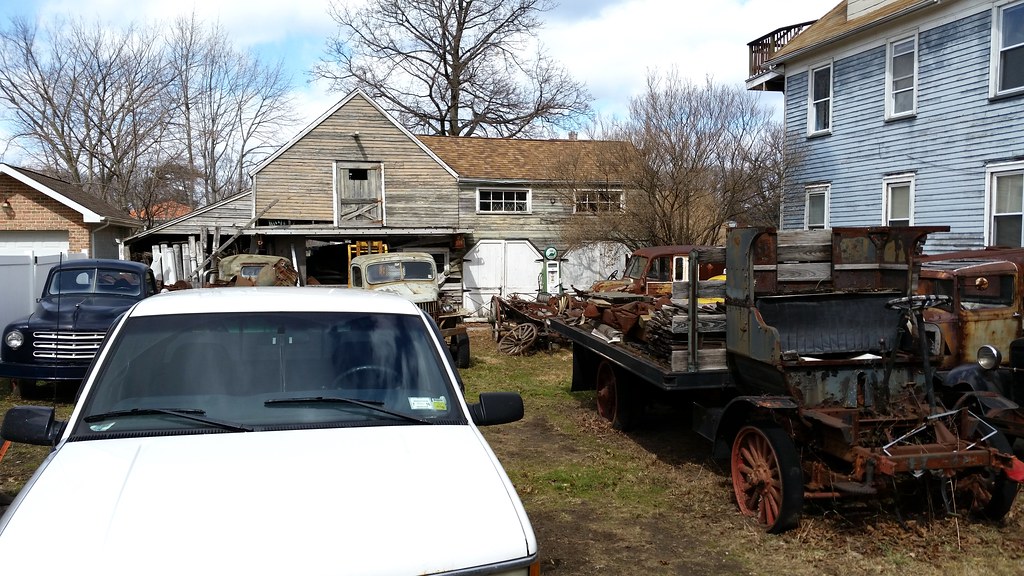


I talked to a renter who lives in the adjacent light blue house, but he didn't know anything about — or even seem remotely interested in — the dozen antique vehicles crammed into his side yard.
We've come across one of these trucks before, by the way, parked just around the corner. It had some rather peculiar occupants at the time.
The building at the rear appears to be an old stable. You can see the hayloft door and a beam above it that would have been used to hoist the hay. And, if you zoom in, you can spot a horseshoe hanging between the two upper-story windows.

35-55 223rd Street, which I've apparently already photographed
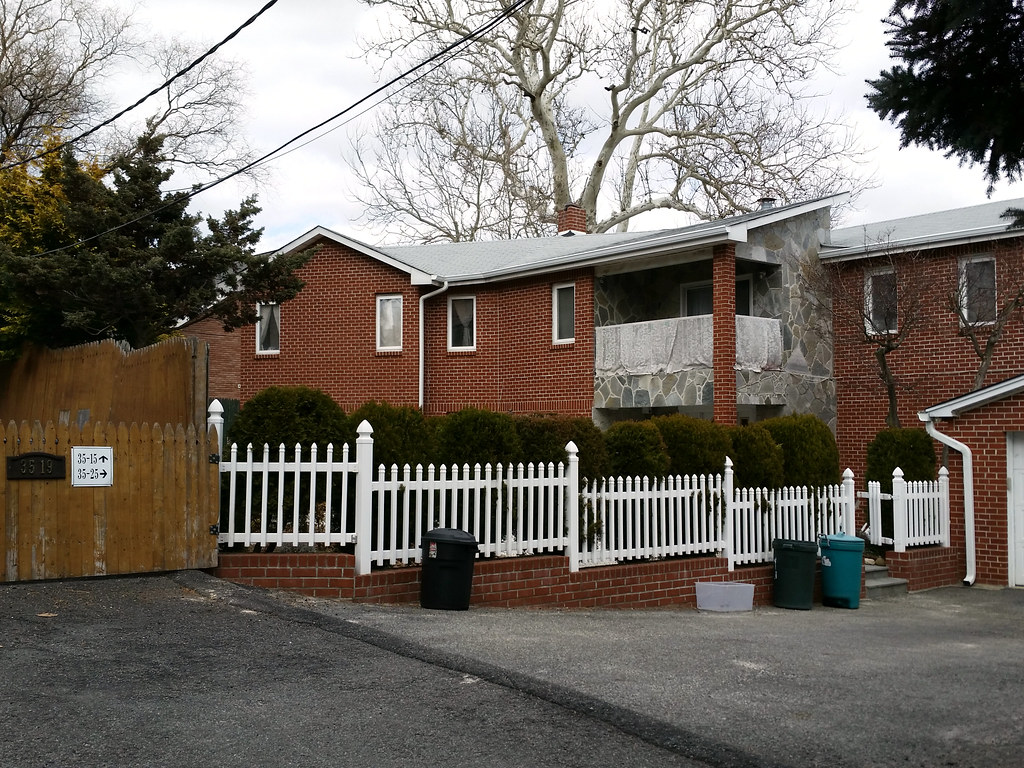
W.C. Fields reportedly resided at this address from 1919 to 1921, although I don't know if he lived in the present house or an earlier one. This view from the other side of the house shows the structure to be much larger than it appears from the street, and also makes it seem like this brick section might be a newer addition to the original house.

This massive concrete wall, lurking in the backyard of a house in Bayside (Street View), has been livened up with what looks like a scene from the Greek island of Santorini.
When I looked up the owners of this property, I was not too shocked to discover that they have very Greek-sounding names: Efthymia and Dimitrios Petridis. I was surprised, however, to learn that they're also the owners of Gyro World.

The Joe Michaels Mile is a mile-long section of the recreational path that runs along the western shore of Little Neck Bay, paralleling the Cross Island Parkway, and is one of the northernmost pieces of the Brooklyn-Queens Greenway. The man for whom it is named was a local fitness advocate who started running as a way to get into shape after suffering several heart attacks, his first at age 27. He went on to complete numerous marathons and ultramarathons — including some Sri Chinmoy races! (Sri Chinmoy was the guru behind the Self-Transcendence 3100 Mile Race.) But even as he was able to transform his body and lifestyle through exercise, Mr. Michaels nonetheless died young of a heart attack, at the age of 45, in 1987.
According to the Parks Department sign above, Mr. Michaels was also once the drummer for Jay and the Americans. I'm not sure if that's true, however. An internet search for evidence of Mr. Michaels's role in the band only turns up articles about the Joe Michaels Mile, which are probably all just based on information from the Parks Department.

Good news: it's for sale! Here's a photographic tour of this Bayside Gables abode, presumably decked out to appear most desirable to potential buyers — I count what appear to be three cowhides: two as rugs and one as upholstery. Also, that's a frosted glass version of Michelangelo's The Creation of Adam in the window above the front door. Take a closer look.

The plaque reads:
IN MEMORY OF
JOHN FITZGERALD KENNEDY
PRESIDENT OF THE UNITED STATES
DEDICATED MEMORIAL DAY, MAY 30, 1964
---
THE BAYSIDE GABLES CIVIC ASSOCIATION

Another large Bayside Gables dwelling. You can take a bird's-eye tour of the neighborhood here.
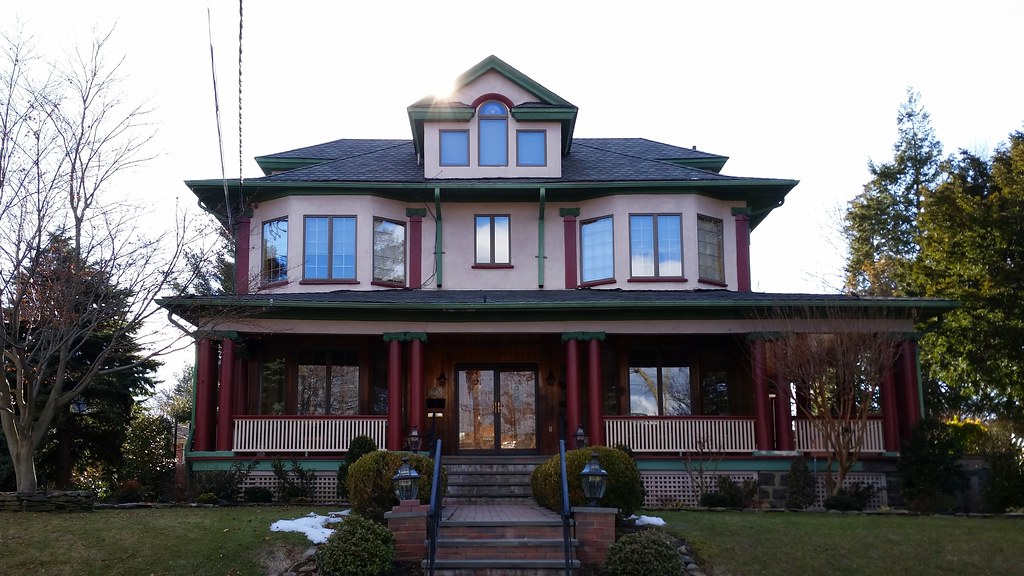
This page offers a little information about the house. More intriguingly, it also notes that a different house in the neighborhood was once home to the daughter of "Henry Clay Weeks . . . the Secretary of the American Society for the Extermination of Mosquitoes".
According to his obituary in the July 2, 1910 Boston Evening Transcript, Mr. Weeks was "said to have been the first man in this country to start the crusade against mosquitoes". And his obit in the Medical Record says he "was the first secretary of the American Society for the Extermination of Mosquitos, and was an active experimenter in carrying on the fight, the present general public interest being largely due to his efforts."
This would make him, I suppose, a grandfather of NYC's ubiquitous sewer dots!
The Christian Advocate adds a little more color to the picture:
It is said that Mr. Weeks and his kerosene oil can at Bayside were the advance guard of the army of mosquito-exterminators which is now abroad in the land. He was largely instrumental in the formation of the American Society for the Extermination of Mosquitoes, and as its secretary was active in its successful campaign of education. Those who laughed at his zeal lived to see State after State appropriate thousands of dollars annually to abate the buzzing pest.His kerosene oil can? That's a reference to one of Mr. Weeks's mosquito-fighting tactics. A 1903 NY Times article explains that his approach involved "destroying the homes and breeding places of the pests by filling and draining and by 'petrolizing.' This latter method consists in covering the stagnant pools and ponds with petroleum, which forms a film over the water, through which the newly hatched [larvae] cannot penetrate."
But why stop there? According to an NY Times piece from 1902, "Mr. Weeks had a greater idea in his mind than the mere abolishing of mosquitos. His plan has been nothing less than the turning of the vast extent of salt and fresh meadow land along the Atlantic Coast, now useless and a blot upon the landscape, to practical account." As explained in the article, he wanted to drain the wetlands and transform them into productive farmland. Of course, from a 21st-century perspective, coastal wetlands are no longer seen as useless or as a blot upon the landscape, but rather as highly valuable ecosystems in need of protection.
Mr. Weeks's NY Times obituary describes him as "an ardent friend of the shade tree and an implacable enemy of the mosquito and all telegraph and telephone companies that string wires above ground". We know all about his hatred of mosquitoes by now, but what does the rest of that quote mean?
The Christian Advocate once again fills us in:
Henry Clay Weeks, of Bayside, L.I., died last Friday at the age of sixty-six. He was a native of this city and long known as a successful builder here. A man of rugged independence of character and intense personal force, he set himself powerfully against certain tendencies of the time in a way that on several occasions placed him before the public. He could not believe that public service corporations had the right to run wires and set poles wherever they pleased in defiance of private ownership, and he resisted the companies with boundless vigor and undiscourageable persistency. He loved natural beauty and was instrumental in the planting of many trees, whose shade will be a blessing to future generations. It outraged his feelings to see the roadside trees maimed and killed by cross-country trolley-lines and the stringing of high-power feed wires through their limbs. Against this he protested through every channel of publicity that he could penetrate. His own means were unselfishly lavished in printer's ink, photographs and postage to tell the people how their possessions were being despoiled by these barbarous improvements in the name of serving the public.(The passage above specifically mentions trolley lines, but a 1908 NY Times article says Mr. Weeks was widely known as "the unrelenting opponent of telephone, telegraph, and electric light companies whose men place their poles and string their wires and cables regardless of choice trees or the likes or dislikes of owners of country places".)
Let's give the man himself the final word here, as he waxes philosophical about his arboreal advocacy. In an address to the American Civic Federation in Cleveland in 1905, Mr. Weeks instructed his audience not just to fight for their own trees, but to
teach thoughtless people of the beauty and value they are allowing to be sacrificed for corporate greed. Arouse them to the importance of the moral issues where companies manipulate pliant public officials. Tell them truly that such courses carried to their ultimate end, will drag our country to ruin. Our contest is against the tree butcher—and to make it effective it is against overhead wires where possible and against the threatening evil of the corporate control of public officials by unworthy means in this contest.

One former resident of this house was Captain Francis Pope, a TWA pilot who was awarded a patent in 1940 for an advanced aircraft radio beacon system. (A Francis Pope of Bayside, NY — presumably the same man — also received a patent for a "selective turbopropeller jet power plant for aircraft", in 1952.)
In 1941, Capt. Pope was interviewed by a sports writer for the Pittsburgh Post-Gazette:
On a recent flight we asked Captain Francis Pope, clean cut pilot on the TWA, what was the chief requirement of a transport pilot. He seemed to be more interested in what was going to happen to Conn in the event he fought Louis, but he took time out to discuss his distinctive work.
"Emotional stability,” he said.
"And by that," your Socrates asked him, "you mean just what?"
"The ability to control your emotions under all circumstances—to act the same under stress as under normal conditions."
"Do you find a trace of fatalism among the pilots?" we pursued.
"Quite the contrary," he said. "As I understand a fatalist—he resigns himself to circumstances he thinks are beyond his control. On the other hand, a pilot is trained to play out his string—to refuse to concede the circumstances are beyond his best effort to overcome them."
"In the event of war for this country what job would you probably draw?"
"About the same one as I'm doing now, I imagine. There would be greater need for transport men than now. To younger men would go the jobs of handling the dive bombers and the pursuit planes, calling for quick maneuverability. They would be on the order of, let us say, basketball players."
At 32, Captain Pope has eight years of service in as a pilot. He is a Leland Stanford grad. To this yokel, he and his colleagues represent the perfect type of homo sapiens. You admire them more, too, at 3,000 feet of altitude.

This appears to be an old carriage house (more photos), and the way it's set back from the surrounding houses on an oddly shaped lot (Lot 71) suggests that it predates the other dwellings on the block. Also, if you compare an aerial image from 1924 with one from 2012, you'll see a building of the same dimensions in the same location in 1924, but without all the newer houses around it.

As we learned a couple of years ago, Mr. Golden was a prominent Broadway producer, and, according to the Parks Department:
He and his wife Margaret moved to Bayside in 1920 and subsequently made their estate available to the community. The well-maintained grounds were often used by neighborhood residents, including golf caddies practicing their swings, little leaguers playing baseball, and Sunday picnickers walking among the gardens. Some Bayside residents remember seeing Golden strolling in his white suit, broad-rimmed hat, and spats, carrying a silver-handled cane.
Upon his death on June 17, 1955, Golden’s will bequeathed his Bayside estate to the City of New York as a park "for the use and enjoyment by the young people of the community of all races and creeds in a manner similar to that in which I made this property available for recreation and community acts during my lifetime."
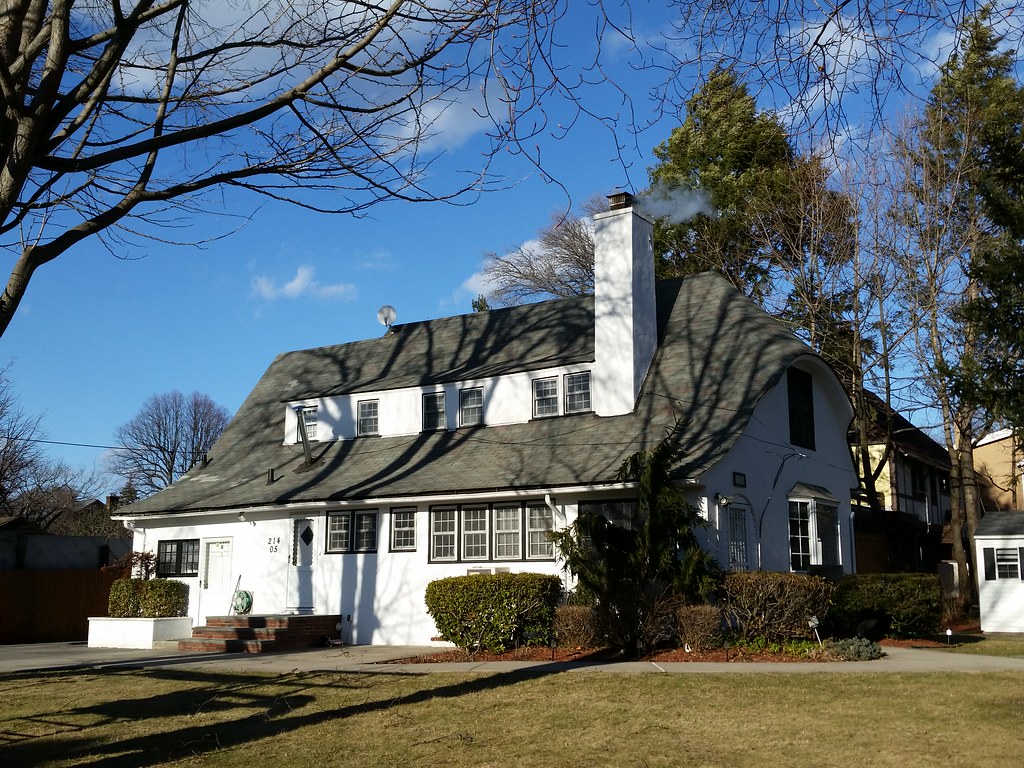
This house, with an unusual curved eave on one side of the roof, was, like the house from a few photos ago, formerly home to an inventor. In this case, the man's name was Edward S. Roberts, and he seems to have been a chemical engineer or something similar. There are at least three patents that were awarded to him at this address, as well as 17 more that I found granted to a New Yorker of the same name — likely the same man, as far as I can tell — but with a different (older) address or no address listed. You can see all 20 patents here.

I took this photo of Uncle Jack's because the three-dimensional sign (close-up) caught my eye. I read about the restaurant's history on its website, and I assumed my post would just offer a brief summary of what I learned — something like this: "Opened in 1996, this steakhouse takes its name from the owner's godfather, who ran a famous Prohibition-era restaurant called Jack's on the Upper West Side."
The website's description of Jack's sounded a little overblown, however:
In the early 1930's, with prohibition still in effect, "Jack's" on the Upper Westside of Manhattan became the premiere location for celebrities, socialites and aristocrats yearning to celebrate the finer things in life. Aside from serving New York's finest steaks, seafood and vegetables, "Jack's" was just as well known for its proprietor and his dedication to quality and high standards – qualities that still define Uncle Jack's today.If Jack's was really "world famous for [its] celebrity clientele" and known as "the place to go for the best steak in New York", surely I would find it mentioned in old books and newspaper articles.
While world famous for his celebrity clientele, "Jack" would greet every guest as if they were family. Everyone who walked through his doors expected the absolute best - and received nothing less. "Jack" handpicked every item his restaurant served. While praised for his delicious steaks and unique menu, "Jack's" special sauce was arguably the main attraction. Legend has it; the sauce – hand crafted in small quantities once a week and stored in an iron vault – was watched more closely than the weekly shipment of whisky barrels from the South!
"Jack's" flourished for years, catering to New York's finest, and became the place to go for the best steak in New York – a title that was proudly passed on to "Uncle Jack's".
It turns out there was a famous Prohibition-era restaurant named Jack's with a well-liked owner, but it doesn't otherwise match the description above. It was located in Midtown (6th Avenue and 43rd Street), not the Upper West Side. It wasn't known for its steaks. It was no longer in existence in the early 1930s, as it closed in 1925. And the owner, John Dunstan, certainly wasn't the godfather of Willie Degel, Uncle Jack's owner: Mr. Dunstan died in 1927 and Mr. Degel wasn't born until 1967 (or possibly 1968?).
(Another Jack who ran a famous Midtown speakeasy — Jack Kriendler of Jack and Charlie's 21 — also died well before Mr. Degel's birth.)
After a bit of searching, I found an NY Times article in which Mr. Degel says Jack was both his uncle (his mother's brother) and his godfather, and from 1925 to 1930 "ran a speakeasy near Columbus Circle with his father, who was also named Jack." I can't find any mention of this establishment on the internet, however. While that doesn't mean it didn't exist, it's pretty compelling evidence that it wasn't the world-famous celebrity hangout described on Uncle Jack's website.
Another article in the Daily News quotes Mr. Degel saying his uncle was named Jack Foley and was the "former boss of the longshoreman's union on the West Side of Manhattan, whose father ran a speakeasy on Columbus Circle". So it was not his uncle (and godfather) who ran the place, but rather his uncle's father. That makes more sense, because his uncle would have had to have been pretty young in 1925.
Additionally, knowing the uncle's family's last name (Foley) should make it even easier to uncover some evidence of the existence of Jack's, but I'm still coming up empty.
So it would seem that the famous Jack's restaurant that "proudly passed on" the title of New York's best steakhouse to Uncle Jack's was, assuming it existed at all, a little-known speakeasy, not the world-renowned steak joint described on Uncle Jack's website.
While fruitlessly searching for information about Jack's, I did discover a few things about Mr. Degel. He has opened two additional Uncle Jack's locations, in Manhattan, and owns an "organic" eatery in Nassau County called Jack's Shack, which is "more than a restaurant — it's a laid-back lifestyle that Mother Earth would be proud of." He was also the host of Restaurant Stakeout, the highly staged "reality" show that aired on the Food Network for five seasons.
Moving on to legal matters, I learned that Mr. Degel was convicted of credit card fraud in 1994. The charges stemmed from his relationship with Lou Ferrante, the former mafia associate turned Orthodox-ish Jew/author of books about mob life and "how the dreaming brain can see the future"/host of the Discovery Channel's Inside the Gangsters' Code.
Mr. Degel also has a third-degree assault conviction on his record for his part in a 1991 incident that reportedly began with him and another man harassing employees at a White Castle in the early morning hours. When an off-duty police officer stepped in, Mr. Degel held back a security guard while his companion beat the officer in the face.
But that's not all! In 1996, the Daily News said Mr. Degel was "awaiting sentencing in another federal hijacking and robbery indictment last year. Sources said Degel is cooperating with federal prosecutors in the case, which has resulted in five guilty pleas."
And while we're on the subject, let's move over to the civil cases. Mr. Degel recently agreed to pay $900,000 to settle a lawsuit in which his employees accused him of "failing to pay . . . minimum wages, overtime wages, spread of hours pay, uniform allowances and . . . misappropriating tips at three restaurants." He has also been sued by his former housekeeper, who claims he didn't pay her overtime wages.
On a final note, Mr. Degel once paid $10,000 for a 1,000-pound cast-iron bull statue that he had installed without a permit in front of Uncle Jack's here in Bayside in 2002. Just over a week after it was put up, the bull was torn down by vandals who severed its horns, tail, and hind legs. Mr. Degel vowed to repair and reinstall the bull, this time atop a sturdy granite pedestal, but I don't know if that ever happened. From 2007 on, the bull is absent from all Street View photos of the restaurant.
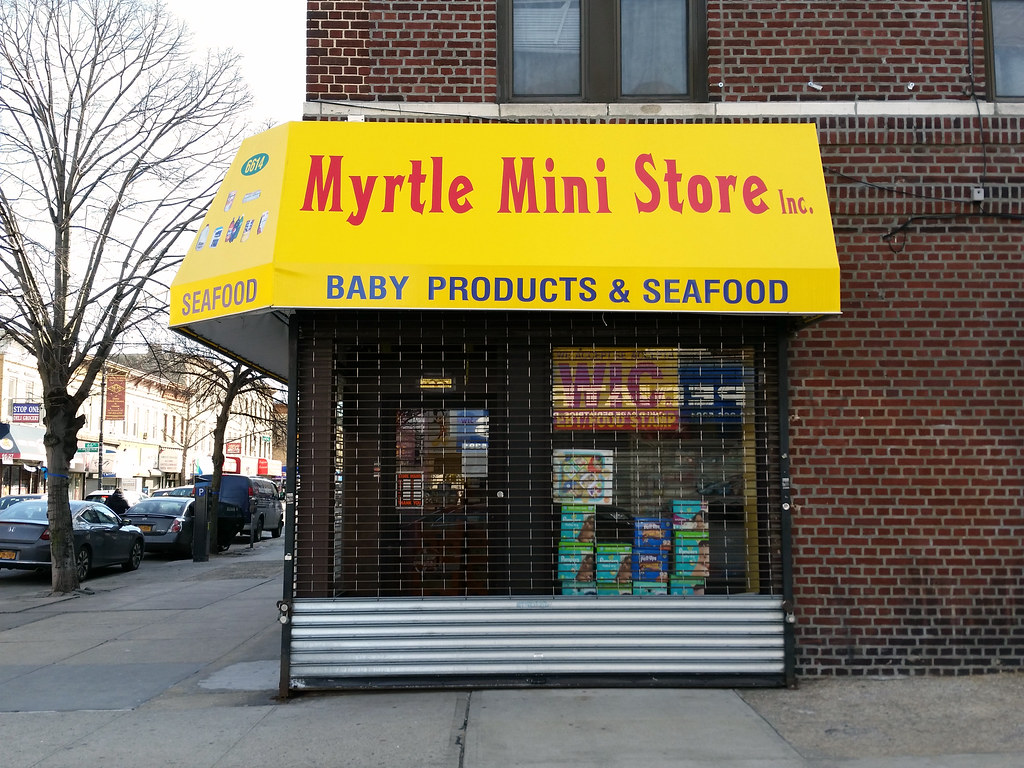
Baby Products & Seafood! From a Yelp review:
I ventured in to discover that, indeed, at the front of the store are various toddler trinkets and merchandise. Then, beyond the disposable diapers, jolly jumpers and sippy cups; beyond the formula, teething rings and other infant paraphernalia; at the very back of the establishment lies a freezer full of fish - frozen shrimp, mussels and what appears to be dried salted cod.
This place delivers what it promises.
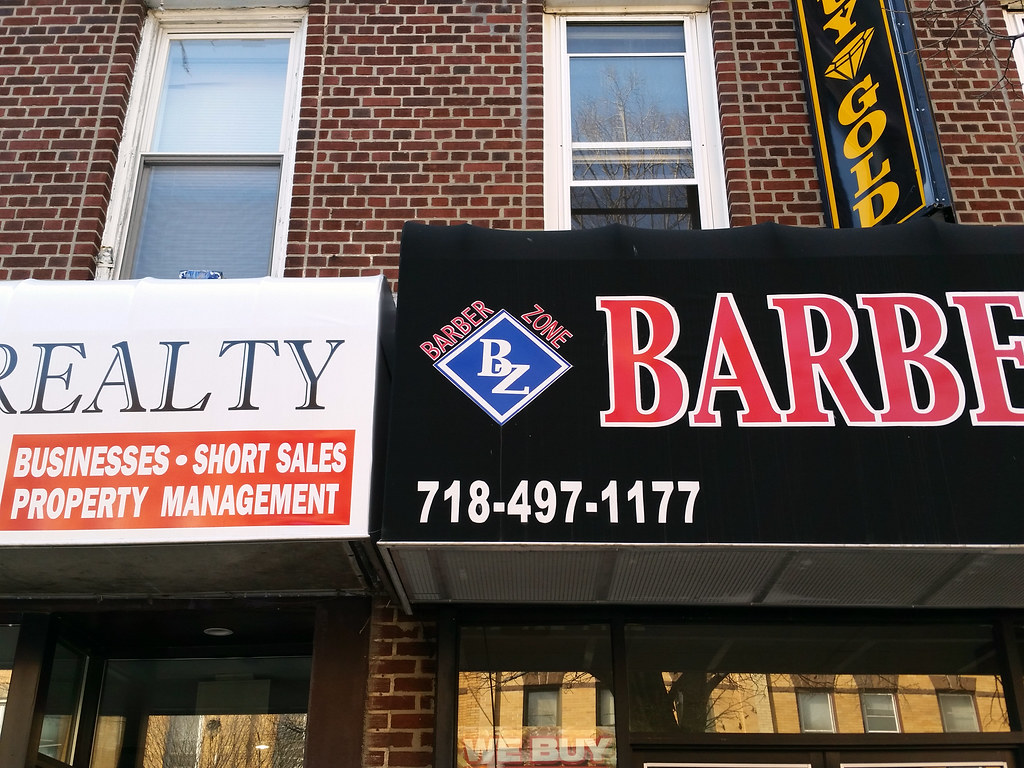
Barber Z(one). The Z has to be in place of an S to count.
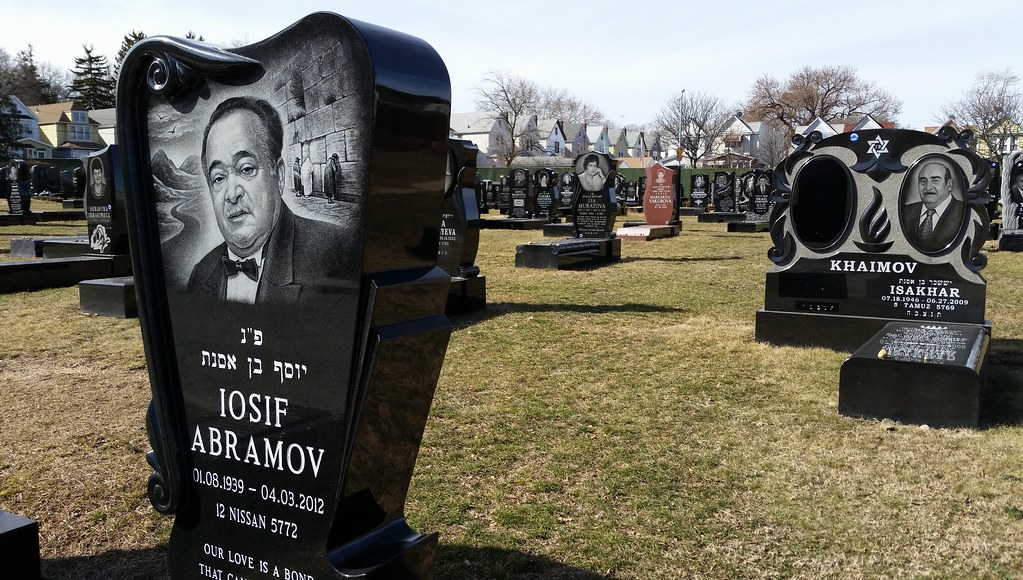
Here in New Mount Carmel Cemetery is a large section of the laser-etched portrait stones that, as we've seen, are popular among Jews from the former Soviet Union.

Among those buried here at New Mount Carmel Cemetery are Henny Youngman and his beloved, though oft-maligned, wife of almost 60 years, Sadie.

A common sight at Jewish cemeteries, gates like this one announce the name of the burial society that owns a particular section of plots.

